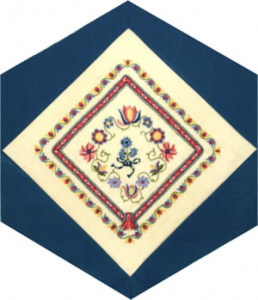Estonia

The Block
Together, friends Helle Arro, Ellen Leivat and Maaja Matsoo collaborated to make the Estonia block. A multi-coloured array of embroidered wildflowers and symbolic patterns surrounding the national flower, the cornflower, reflects the Estonian’s love of nature. Incorporating the Estonian colours of blue, black and white, an intricate finger woven bow completes the floral centre. The red and white woven band framing the blossoms is a handwoven reproduction, by Daphne Howells, of a very old decoratively braided vöö (belt) used as part of the native costume and also given as gifts. A variety of stitches, including chain stitch, vorkpiste and satin stitch create a complex border of stylized flowers commonly used in both clothing and household linens. The detailed design is beautifully produced on a traditional linen background.
Cultural Profile
Estonia, a republic in northeastern Europe, is home to more than 1,500 islands. Ethnic Estonians make up the majority of the population, followed by Russians. Almost 70 percent of the people live in cities or towns, but Estonians cherish the countryside and even urban dwellers maintain strong rural ties. The official language is Estonian, which is similar to Finnish. Many words in Estonian and Finnish are actually spelled and pronounced the same, but they have completely different meanings. This is said to be the source of many jokes in both languages. However, these two languages are not mutually intelligible.
The territory of present-day Estonia was always inhabited by Estonians, while Swedes, Germans, Danes and Russians all had an impact on the local culture at some point in the country’s history. The name of the capital, Tallinn, is said to be derived from the Estonian taani linn, meaning ‘Danish Town’. During the period of 1860-1880, known as ‘the national awakening,’ several cultural traditions began in Estonia, including the massive Estonian Song Festival, the Laulupidu, held every five years. Amateur singing organizations host the event which features 30,000 singers and has over 80,000 attendees. Folk songs are an important part of Estonian culture and the country has a rich oral tradition of songs, verses and chants that encompass the seasons, farming, family life, love and myths. There are indeed 130,000 different folk songs recorded in written form in Estonia. The oldest song type, a runic chant, goes back to the first millennium BC.
The Estonia Folk Festival, apart from playing a major role in the preservation of Estonian songs, has also helped in the preservation of regional folk costumes, as they are seen as a central part of the performance. Costumes vary from region to region. They are made of linen and wool, the two traditional materials, and feature intricately embroidered white blouses, vests, aprons and ankle-length skirts. Jewellery such as the emblematic conical brooch and a chain with pendant coins are also prominent features of the traditional costume. Observance of the clothing traditions were once so important that a woman marrying a man from another region would wear the costume of her region of origin until her death. Today, the women on the island of Kihnu, known for their self-reliant spirit as the men spend most of their time at sea, still proudly wear their traditional costume in everyday life, a rarity in Europe.
Other aspects of the culture, including handicrafts, architecture and everyday life, have been greatly influenced by Germany. Estonians are known for their love of music and dance, choirs, drama, folk art, weaving, and colourful, traditional embroidery. Tablet weaving is used to create sashes, decorative bands applied on clothing, and belts. On the island of Muhu, black wool is used to create various items on which flowers are then embroidered with vivid colours. Knitting is also very popular in the country. Items such as gloves, scarves and sweaters with typical Nordic patterns are common in the country. The Haapsalu shawl, made of knitted lace, showcases the ability of Estonian knitters to produce lacy fabric that is so fine and light that, despite being 150 cm wide, it can fit through a wedding ring.
Estonians have been coming to Canada since the 1900s. Many who came after 1940 were middle-class professionals (engineers, medical doctors, etc.) who were placed as farm hands in Alberta for a one year term. Once the year was up and their knowledge of the language had improved, almost all moved to cities where they took on more skilled work or started their own businesses. Estonians have assimilated well into Canadian society while maintaining a strong structure of ethnic organizations. For instance, Estonian House in Toronto is comprised of, among other things, a doctor’s office, library, credit union, newspaper and bookshop, and souvenir shop. The Estonian Ethnographic Society of Toronto was established thirty years ago to preserve and pass on traditional music, customs, textiles and culture. Estonians have contributed in many ways to the Canadian fabric, most noticeably in the development of amateur sports, architecture and the construction industry. The 2011 census indicates there are over 23,000 Canadians of Estonian origin, now living in Canada, with sizeable Estonian communities located in Toronto, Montréal, Vancouver and Hamilton.
Sponsor: Estonian Ethnographic Society of Canada
